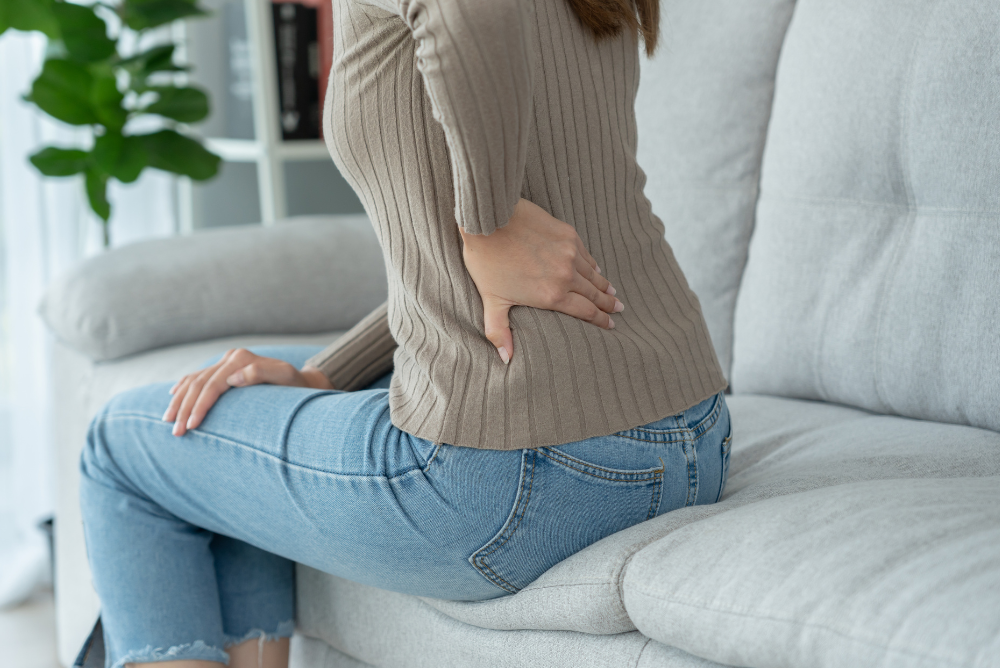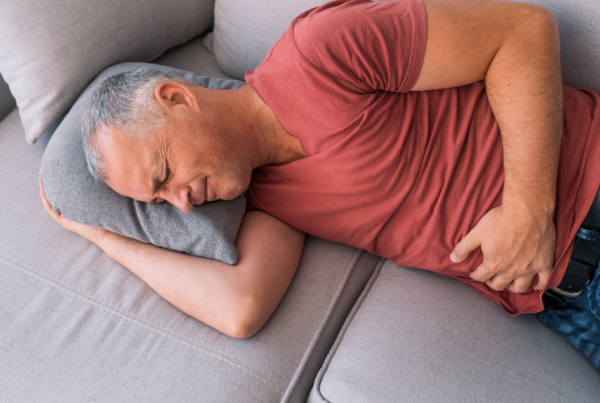Hip Pain
Move Better. Live Fuller. Your Wellness Journey Starts Here.
Schedule a FREE Discovery Call!
About Hip Pain
The hip joints are the largest ball-and-socket joints in the body. They support your body weight and allow you to enjoy activities throughout the day. These joints are meant for a high degree of mobility and weight distribution, so they experience wear and tear over time.
This wear and tear, coupled with soft tissue changes around the joint such as tightness, weakness, and poor coordination can cause symptoms of hip pain. This pain can make your daily activities and exercise more difficult or impossible. The effects of hip pain vary widely depending on the cause, underlying conditions, and medical history of a patient.
Hip pain can range from acute to chronic depending on the length of time they have been bothering you, and symptoms can vary from person to person.

Understanding your own symptoms can help you better communicate your experience to your provider, allowing them to identify possible causes and outline a treatment program for you. Common symptoms of hip pain you may experience include:
- Pain or radiating pain: Pain can be felt in or around the hip, as well as radiate to other areas such as the thighs, groin, or back.
- Loss of function: As a result of pain or changes in bone structure, you may experience a loss of motion as well as decreased strength and flexibility. This affects the overall function of the hip, making it difficult to complete daily activities such as climbing stairs, walking long distances, or transferring from sitting to standing positions. This includes completing exercises or activities such as squatting, running, biking, or jumping.
- Weakness: You may feel a loss of strength in or around your hips. This loss of strength may contribute to you feeling more pain, or it may make it challenging to perform certain activities that you once found easy.
- Stiffness: Your hip may have a loss of motion, oftentimes this is reported as a feeling of stiffness or a difficulty with moving. This can either occur after a lot of movement, or after a period of low to no movement (such as after sleeping).
- Swelling and inflammation: In some cases, especially with certain injuries or diseases, the hip area may be swollen, tender, warm, or inflamed.
- Clicking or popping sensations: You may feel that your hip joints “catch” during movement. In some cases, individuals may feel a clicking or popping sensation.
- Difficulty sleeping: Pain and tenderness can make it difficult to sleep on your side or turn over, resulting in a disruption to your normal sleeping habits.
What Causes Hip Pain?
Hip pain is a general term that describes a variety of conditions. However, these conditions differ in a few different aspects. As mentioned earlier, hip pain can be found directly in or around the hip. It can also radiate to other parts of the body. The location of your pain often ties directly to the cause of the pain, as hip pain can be caused either by issues with the actual hip structure or by the other surrounding structures. So, let’s look at some conditions that may create hip pain, including those that originate from the hip itself as well as the other parts of the body.
Hip Pain From the Hip Joint
Osteoarthritis: This is a form of arthritis marked by the changing and breaking down of tissue and cartilage within the joint. It is often called degenerative joint disease.
Femoroacetabular impingement (FAI): This condition refers to abnormalities in the shape of one or both hip joint bones, which creates friction and damage to the joint.
Labral tear: This is an injury to the soft tissue called the labrum, which surrounds and deepens the cup that the ball sits within.
Hip dysplasia: This condition occurs when the ball and socket do not fit correctly due to the socket being too shallow.
Hip Pain From Surrounding Structures
Bursitis: Small, fluid-filled sacs called bursae help cushion the area between your joints, muscles, and tendons. The sacs can become inflamed due to abnormal wear or friction that is caused by muscle imbalance, poor coordination, or improper body mechanics.
Tendinitis: Inflammation and swelling of the tendons, most often due to overuse or improper movement patterns.
Muscle or tendon strain: Muscles and tendons are one and the same, as the tendon attaches the muscle to the bone. If this structure is overly stretched or in some instances torn slightly or fully, this can cause pain in or around the hip.
Snapping hip syndrome: This involves the sensation or sound of popping or clicking in the hip area during movement. It is caused by a muscle or tendon that is moving over a bony protuberance.
Sciatica: Sciatica is pain, numbness, or tingling that radiates from the hip/buttocks region and travels down the leg. It can be caused from pressure being applied to the nerves, because of a herniated disc, or from tight muscles.
Pelvic floor muscle dysfunction: The pelvic floor muscles and hip muscles are very close in proximity, and some hip muscles even act as additional supports to the pelvic floor. Because of this, someone experiencing pelvic floor-related pain or dysfunctions may experience issues with their hips and vice versa.
Referred pain: General pain from the lower back, legs, or pelvic floor can radiate to the hips. Oftentimes the patient believes it is their hip when in reality, the pain’s origin is in another area of the body.
Pregnancy: Your body relaxes the joints and ligaments of the pelvic area while preparing for pregnancy and birth. Therefore, hip pain is commonly felt during the second and third trimesters.
Hamstring or quadriceps strain: Strains in these nearby muscles can cause hip pain.
Piriformis syndrome: Similar to sciatica, but in this case the piriformis muscle is pressing on one area of the sciatic nerve in the buttocks; causing pain that can be felt in the lower back, buttocks, hips, legs, and even the foot.
Iliopsoas impingement: Also known as snapping hip syndrome, this involves inflammation of the iliopsoas muscle, which results in abnormal hip motions and pain.
IT band syndrome: This condition is caused by tightness in a band of tissue that extends to the shinbone from the pelvic bone. This tightness can create pain in the hips and knees.
Physical Therapy for Hip Pain
In many cases, a physical therapist can diagnose and treat your hip pain. A physical therapist can identify possible causes of your symptoms, and work to create an individualized plan of care to solve them. Treatment can vary from person to person, but can often involve addressing strength, function, and flexibility issues in the hip. Physical therapists are skilled in providing treatments that can relieve pain while addressing your other needs.
Diagnosis always includes a look at your medical history and examination of your symptoms. Your physical therapist will likely ask what makes your symptoms worse, what alleviates them, and how they impact your daily life. They may perform a visual and physical examination to look for abnormalities, where the pain originates, and what areas are affected. They will test your walking patterns, range of motion, and the strength of the muscles around the affected hip. Your physical therapist may have you perform tasks such as walking, climbing stairs, or standing up from a seated position to test your hip’s function further.
In some cases, your physical therapist may use special tests to examine individual structures of the hip and check for other conditions. These tests may include:
- FABER (Flexion, Abduction, and External Rotation) test: Helps identify sacroiliac joint dysfunction, hip pathology, or groin strain.
- Thomas test: Reveals hip flexor tightness.
- Trendelenburg test: Helps to indicate weakness in the hip abductor muscles.
Your physical therapist will gather all the relevant information from your medical history, description of your symptoms, and the results of your examinations or tests; they will then use them to determine a diagnosis and treatment plan. In your plan of care, you can expect manual therapy, exercises, pain management strategies, and education on activity modification. Some specific treatments utilized by the physical therapists at Hive Therapy and Wellness include the following:
- Dry needling
- Cupping
- Manual therapy
- Spinal manipulation
- Electrical muscle stimulation
- Tissue scraping
- Exercise prescription
- Therapeutic modalities
- Neuromuscular re-education
- Therapeutic activity
The hip joints are the largest ball-and-socket joints in the body. They support your body weight and allow you to enjoy activities throughout the day. These joints are meant for a high degree of mobility and weight distribution, so they experience wear and tear over time.
This wear and tear, coupled with soft tissue changes around the joint such as tightness, weakness, and poor coordination can cause symptoms of hip pain. Hip pain can make your daily activities and/or exercise more difficult or even impossible.
Hip pain can vary widely from person to person depending on the cause, underlying conditions, and medical history. The symptoms can range from acute to chronic depending on the length of time they have been bothering you.
Understanding your hip pain can help you better communicate your experience to your provider, allowing them to identify possible causes and outline a treatment program for you. Common symptoms of hip pain you may experience include:
Pain or radiating pain
Pain can be felt in or around the hip, as well as radiate to other areas such as the thighs, groin, or back.
Loss of function
As a result of pain or changes in bone structure, you may experience a loss of motion as well as decreased strength and flexibility.
This affects the overall function of the hip, making it difficult to complete daily activities such as climbing stairs, walking long distances, or transferring from sitting to standing positions. This includes completing exercises or activities such as squatting, running, biking, or jumping.
Weakness
You may feel a loss of strength in or around your hips. This loss of strength may contribute to you feeling more pain, or it may make it challenging to perform certain activities that you once found easy.
Stiffness
Your hip may have a loss of motion, oftentimes this is reported as a feeling of stiffness or a difficulty with moving. This can either occur after a lot of movement, or after a period of low to no movement (such as after sleeping).
Swelling and inflammation
In some cases, especially with certain injuries or diseases, the hip area may be swollen, tender, warm, or inflamed.
Clicking or popping sensations
You may feel that your hip joints “catch” during movement. In some cases, individuals may feel a clicking or popping sensation.
Difficulty sleeping
Pain and tenderness can make it difficult to sleep on your side or turn over, resulting in a disruption to your normal sleeping habits.
Hip pain is a general term that describes a variety of conditions. However, these conditions differ in a few different aspects. As mentioned earlier, hip pain can be found directly in or around the hip. It can also radiate to other parts of the body.
The location of your pain often ties directly to the cause of the pain, as hip pain can be caused either by issues with the actual hip structure or by the other surrounding structures. So, let’s look at some conditions that may create hip pain, including those that originate from the hip itself as well as the other parts of the body.
Hip Pain From the Hip Joint
- Osteoarthritis: This is a form of arthritis marked by the changing and breaking down of tissue and cartilage within the joint. It is often called degenerative joint disease.
- Femoroacetabular impingement (FAI): This condition refers to abnormalities in the shape of one or both hip joint bones, which creates friction and damage to the joint.
- Labral tear: This is an injury to the soft tissue called the labrum, which surrounds and deepens the cup that the ball sits within.
- Hip dysplasia: This condition occurs when the ball and socket do not fit correctly due to the socket being too shallow.
Hip Pain From Surrounding Structures
- Bursitis: Small, fluid-filled sacs called bursae help cushion the area between your joints, muscles, and tendons. The sacs can become inflamed due to abnormal wear or friction that is caused by muscle imbalance, poor coordination, or improper body mechanics.
- Tendinitis: Inflammation and swelling of the tendons, most often due to overuse or improper movement patterns.
- Muscle or tendon strain: Muscles and tendons are one and the same, as the tendon attaches the muscle to the bone. If this structure is overly stretched or in some instances torn slightly or fully, this can cause pain in or around the hip.
- Snapping hip syndrome: This involves the sensation or sound of popping or clicking in the hip area during movement. It is caused by a muscle or tendon that is moving over a bony protuberance.
- Sciatica: Sciatica is pain, numbness, or tingling that radiates from the hip/buttocks region and travels down the leg. It can be caused from pressure being applied to the nerves, because of a herniated disc, or from tight muscles.
- Pelvic floor muscle dysfunction: The pelvic floor muscles and hip muscles are very close in proximity, and some hip muscles even act as additional supports to the pelvic floor. Because of this, someone experiencing pelvic floor-related pain or dysfunctions may experience issues with their hips and vice versa.
- Referred pain: General pain from the lower back, legs, or pelvic floor can radiate to the hips. Oftentimes the patient believes it is their hip when in reality, the pain’s origin is in another area of the body.
- Pregnancy: Your body relaxes the joints and ligaments of the pelvic area while preparing for pregnancy and birth. Therefore, hip pain is commonly felt during the second and third trimesters.
- Hamstring or quadriceps strain: Strains in these nearby muscles can cause hip pain.
- Piriformis syndrome: Similar to sciatica, but in this case the piriformis muscle is pressing on one area of the sciatic nerve in the buttocks; causing pain that can be felt in the lower back, buttocks, hips, legs, and even the foot.
- Iliopsoas impingement: Also known as snapping hip syndrome, this involves inflammation of the iliopsoas muscle, which results in abnormal hip motions and pain.
- IT band syndrome: This condition is caused by tightness in a band of tissue that extends to the shinbone from the pelvic bone. This tightness can create pain in the hips and knees.
In many cases, a physical therapist can diagnose and treat your hip pain. A physical therapist can identify possible causes of your symptoms, and work to create an individualized plan of care to solve them.
Treatment can vary from person to person, but can often involve addressing strength, function, and flexibility issues in the hip. Physical therapists are skilled in providing treatments that can relieve pain while addressing your other needs.
Diagnosis always includes a look at your medical history and examination of your symptoms. Your physical therapist will likely ask what makes your symptoms worse, what alleviates them, and how they impact your daily life.
They may perform a visual and physical examination to look for abnormalities, where the pain originates, and what areas are affected.
They will test your walking patterns, range of motion, and the strength of the muscles around the affected hip. Your physical therapist may have you perform tasks such as walking, climbing stairs, or standing up from a seated position to test your hip’s function further.
In some cases, your physical therapist may use special tests to examine individual structures of the hip and check for other conditions. These tests may include:
- FABER (Flexion, Abduction, and External Rotation) test: Helps identify sacroiliac joint dysfunction, hip pathology, or groin strain.
- Thomas test: Reveals hip flexor tightness.
- Trendelenburg test: Helps to indicate weakness in the hip abductor muscles.
Your physical therapist will gather all the relevant information from your medical history, description of your symptoms, and the results of your examinations or tests; they will then use them to determine a diagnosis and treatment plan.
In your plan of care, you can expect manual therapy, exercises, pain management strategies, and education on activity modification. Some specific treatments utilized by the physical therapists at Hive Therapy and Wellness include the following:
- Dry needling
- Cupping
- Manual therapy
- Spinal manipulation
- Electrical muscle stimulation
- Tissue scraping
- Exercise prescription
- Therapeutic modalities
- Neuromuscular re-education
- Therapeutic activity
You can learn more about these treatments on our Treatments Page.





